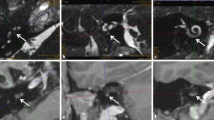Abstract
The objective of the study was to determine the temporal occurrence of cochlear obliteration following translabyrinthine vestibular schwannoma resection. A retrospective chart review, cross-sectional study, and sequential analysis of the time series were performed. The retrospective study included patients undergoing translabyrinthine resection for stage T1–T2 vestibular schwannoma from 2007 to 2010 without prior therapy and postoperative follow-up including MRI of the brain and the cerebellopontine angle. Already 3 months after surgery a radiographic labyrinthine change was observed in 66.7 %, a partial obstruction in 50 %, and an obstruction limited to the saccule in 16.7 %. Only 33.3 % of the patients showed an unchanged inner ear. In consideration of early cochlear obstruction after translabyrinthine vestibular schwannoma resection, temporary follow-up is necessary. Since the indications for cochlear implantation (CI) have been extended, especially concerning patients with single-side deafness, a simultaneous or early second-stage CI after tumour removal should be discussed.



Similar content being viewed by others
References
Swartz JD, Mandell DM, Faerber EN et al (1985) Labyrinthine ossification: etiologies and CT findings. Radiology 157(2):395–398
Warren FM 3rd, Kaylie DM, Aulino JM, Jackson CG, Weissman JL (2006) Magnetic resonance appearance of the inner ear after hearing-preservation surgery. Otol Neurotol 27(3):393–397
Perlmann H, Kimura R, Fernandez C (1959) Experiments on temporary obstruction of the internal auditory artery. Laryngoscope 69:591–612
Belal A (1980) Pathology of vascular sensorineural hearing impairment. Laryngoscope 90:1831–1839
Belal A (2001) Is cochlea implantation possible after acoustic tumor removal? Otol Neurotol 22:497–500
Zanetti D, Campovecchi CB, Pasini S, Nassif N (2008) Simultaneous translabyrinthine removal of acoustic neuroma and cochlea implantation. Auris Nasus Larynx 35:562–569
Rahmeh C, Magnan J (2010) Quality of life of patients following stages III–IV vestibular schwannoma surgery using the retrosigmoid and translabyrinthine approaches. Auris Nasus Larynx 37(5):546–552 Epub 2010 Feb 24
Wiegand DA, Fickel V (1989) Acoustic neuroma—the patient’s perspective: subjective assessment of symptoms, diagnosis, therapy, and outcome in 541 patients. Laryngoscope 99(2):179–187
Hoffmann R, Kohan D, Cohen N (1992) Cochlea implants in management of bilateral acoustic neuromas. Am J Otol 13:525–528
Shin YJ, Frayssee B, Sterkers O, Bouccara D, Rey A, Lazorthes Y (1998) Hearing restoration in posterior fossa tumours. Am J Otol 19:649–653
Hulka F, Benard EJ, Pillsburg HC (1995) Cochlea implantation in a patient after removal of an acoustic neuroma. The implication of magnetic resonance imaging with gadolinium on patient management. Arch Otolaryngol Head Neck Surg 121:465–468
Chen DA, Linthicum FH, Rizer FM (1988) Cochlea histopathology in the labyrinthectomized ear: implications for cochlea implantation. Laryngoscope 98(11):1170–1172
Belal A Jr, Linthicum FH Jr, House WF (1982) Acoustic tumor surgery with preservation of hearing. A histopathologic report. Am J Otol 4(1):9–16
Lee IH, Kim HJ, Chung WH et al (2010) Signal intensity change of the labyrinth in patients with surgically confirmed or radiologically diagnosed vestibular schwannoma on isotropic 3D fluid-attenuated inversion recovery MR imaging at 3 T. Eur Radiol 20:949–957
Bhadelia RA, Tedesco KL, Hwang S et al (2008) Increased cochlear fluid-attenuated inversion recovery signal in patients with vestibular schwannoma. Am J Neuroradiol 29:720–723
Durisin M, Bartling S, Arnoldner C et al (2010) Cochlea osteogenesis after meningitis in cochlear implant patients: a retrospective analysis. Otol Neurotol 31(7):1072–1078
Brandon I, Booth T, Kutz JW, Lee KH, Roland PS (2009) Labyrinthitis ossificans: How accurate is MRI in predicting cochlea obstruction? Otolaryngol Head Neck Surg 140:692–696
Thomsen J, Stougaard M, Becker B, Tos M, Jennum P (2000) Middle fossa approach in vestibular schwannoma surgery. Postoperative hearing preservation and EEG changes. Acta Otolaryngol 120:517–522
Aristegui M, Denia A (2005) Simultaneous cochlea implantation and translabyrinthine removal of vestibular schwannoma in an only hearing ear: report of two cases (neurofibromatosis type 2 and unilateral vestibular schwannoma). Otol Neurotol 26:205–210
Kveton JF, Abbot C, April M, Drumheller G, Cohen N, Poe DS (1989) Cochlear implantation after transmastoid labyrinthectomy. Laryngoscope 99:610–613
Tono T, Ushisako Y, Morimitsu T (1997) Cochlear implantation in an intralabyrinthine acoustic neuroma patient after resection of an intracanalicular tumor. Adv Otorhinolaryngol 52:155–157
Ahsan S, Telischi F, Hodges A, Balkany T (2003) Cochlea implantation concurrent with translabyrinthine acoustic neuroma resection. Laryngoscope 113:472–474
Arriga MM, Marks CS (1995) Simultaneous cochlea implantation and acoustic neuroma resection: imaging considerations, technique and functional outcome. Otolaryngol Head Neck Surg 112:325–328
Zwolan TA, Shepard NT, Niparko JK (1993) Labyrinthectomy with cochlea implantation. Am J Otol 14:220–223
Lustig LR, Yeagle J, Niparko JK, Minor LB (2003) Cochlear implantation in patients with bilateral Ménière′s disease. Otol Neurotol 4:397–403
Graham J, Lynch C, Weber B, Stollverck L, Wei J, Brookes G (1999) The magnetless Clarion cochlear implant in a patient with neurofibromatosis 2. J Laryngol Otol 113:458–463
Temple RH, Axon PR, Ramsden RT, Keles N, Deger K, Yucel E (1999) Auditory rehabilitation in neurofibromatosis type 2: a case of cochlea implantation. J Laryngol Otol 113:161–163
Xu HX, Joglekar SS, Paparella MM (2009) Labyrinthitis ossificans. Otol Neurotol 30(4):579–580
Roehm PC, Mallen-St Clair J, Jethanamest D, Golfinos JG, Shapiro W, Waltzman S, Roland JT Jr (2011) Auditory rehabilitation of patients with neurofibromatosis Type 2 by using cochlea implants. J Neurosurg 115(4):827–834
Carlson ML, Breen JT, Driscoll CL, Link MJ, Neff BA, Gifford RH, Beatty CW (2012) Cochlea implantation in patients with neurofibromatosis type 2: variables affecting auditory performance. Otol Neurotol 33(5):853–862
Caye-Thomasen P, Dethloff T, Hansen S, Stangerup SE, Thomsen J (2007) Hearing in patients with intracanalicular vestibular schwannomas. Audiol Neurootol 12(1):1–12
Conflict of interest
None.
Author information
Authors and Affiliations
Corresponding author
Rights and permissions
About this article
Cite this article
Beutner, C., Mathys, C., Turowski, B. et al. Cochlear obliteration after translabyrinthine vestibular schwannoma surgery. Eur Arch Otorhinolaryngol 272, 829–833 (2015). https://doi.org/10.1007/s00405-013-2877-2
Received:
Accepted:
Published:
Issue Date:
DOI: https://doi.org/10.1007/s00405-013-2877-2




